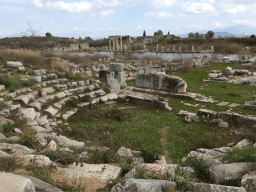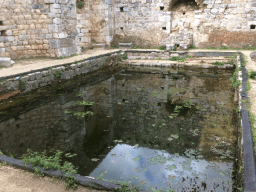
After a pleasant buffet breakfast, with as much variety as one could want, our group departed the hotel. Leaving at a civilized 9:00am we travelled south for about an hour to Miletos.
The earliest traces of settlement at Miletos date to the late Chalcolithic Period (2nd half 4th millennium BC). The first Greeks appeared on the site possibly around 1100BC (at the end of the Bronze Age) and Miletos reached the height of its power in the 6th Century BC. Once positioned on the mouth of two harbours, over time silting of the Meander River now has Miletos several kilometres from the coast.
Upon arrival our group immediately spotted the theatre (it was hard to miss) and made our way directly there. Climbing and positioning ourselves on the seating we listened to Oguz speak a little about the history of Miletos, its famous theatre and the differences to be found between Greek and Roman theatres. After thoroughly exploring the theatre we were led to the different areas of the Miletos site, spending some time in the Agora, which on the day of our visit was flooded in parts (several of our group took to attempting to skip stones as we admired the surroundings) and the Roman bath.
From Miletos we got back on the bus and Ali drove us to Didyma. During ancient times these two locations were connected by the 16.5km long Sacred Way but we, fortunately, took only around 15min to traverse the distance (the joys of modern transportation).
Our first stop in Didyma was not the ancient Temple of Apollo (the third largest temple of the ancient world) but was, instead, to lunch in the quaint, little Turkish town (called Didim) that now occupies the site around the Temple.
The temple itself was a short but spectacular visit, the site of the ruins is small but the ruins themselves are large and imposing. You walk first through a 'forest of columns' before travelling down a sloping tunnel and entering the open space that makes the temple unique.
Our last stop of the day was a leather factory where we were treated to a catwalk display showing off the company's jackets and coats (several of our group have found their calling, should the whole history 'thing' not work out) before wishfully looking through the company’s showroom.

